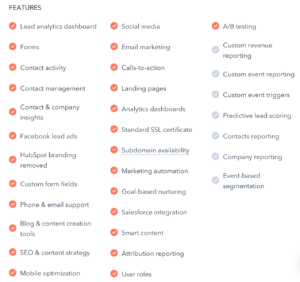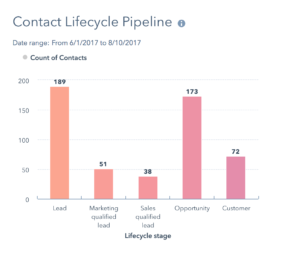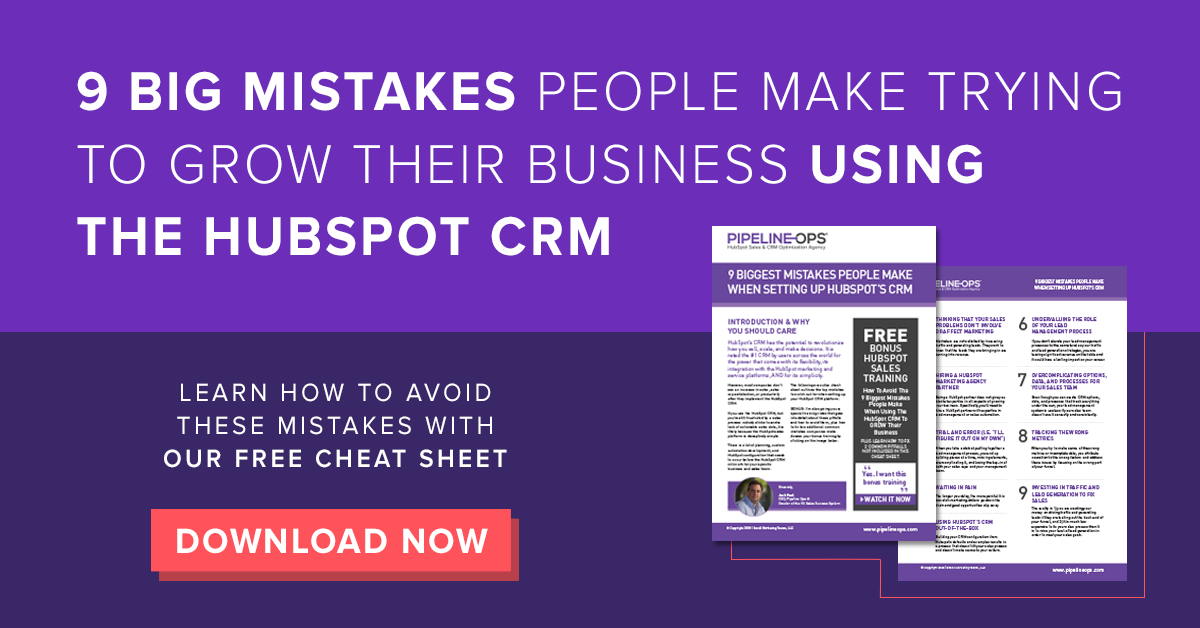The Biggest Difference Between HubSpot Basic and HubSpot Professional: Marketing Automation and Lead Nurturing
By the time you visit HubSpot’s pricing page, they assume that you have done your research and possibly even had an in-depth conversation with a HubSpot rep or partner.
However, that is not always the case. Pricing and package options are one of the first things people look at to determine if it is worth their time to schedule a live demo or conversation.
In those cases, it is difficult to tell the full story and highlight feature options in detail on a pricing page without overwhelming prospective customers. HubSpot is no different.
The functional differences between HubSpot’s Basic and Professional packages comes down to seven checkboxes. These options result in major differences in what is included and what is not within each package.
Below, I will outline some of the most important differences between the Basic and Professional levels, so you can make the best decision for your business.
Which Is Better for Increasing Leads and Sales? HubSpot Basic or HubSpot Professional
At first glance, the differences can seem minor. With HubSpot Basic, you still get almost 20 items on the pricing page feature list, so missing out on the extra seven can feel like a small price to pay.
In fact, HubSpot Basic gives you everything you need to fill the top of your funnel. You can blog, send email campaigns, capture lead information with landing pages, and spread your message through social media.
Where HubSpot Basic falls short is bringing leads down the funnel and efficiently turning leads into customers. For that, you’ll need more than top of the funnel marketing tools.
How Marketing Automation in HubSpot Professional Helps You Increase Leads and Sales
One of the most powerful ways to grow your business is by generating more leads and making more sales. HubSpot Basic doesn’t provide you with the tools you need to do that. HubSpot Professional does - in the form of marketing automation.
For the purposes of this guide, I am going to focus on marketing automation as the one key feature that is included in HubSpot Professional, but not in HubSpot Basic. I am going to put the other differentiating features, like the Salesforce integration, smart content, A/B testing, and user roles, aside.
What is Marketing Automation?
Marketing automation is one of those catchall buzzwords that means different things to different people. This can result in confusion about what it provides and what you are giving up if you choose a level that does not include marketing automation.
At its most basic, marketing automation tools allow you to set up workflows that trigger actions and next steps without your team having to perform the task manually, as they’re likely doing now.
Some people think they are not ready for marketing automation and can grow into it later. Others think it is nice-to-have, but not a must-have functionality. Many see the $600/month price difference between HubSpot Basic and Professional and want to make sure their team can get results at the $200/month level before committing to $800/month.
It is easy to see why people make these decisions when a term that already has definition problems, like marketing automation, is reduced to a single feature checkbox on a pricing page.
That is why is it important to look beyond the feature description on the HubSpot website and analyze the tactics and strategies where HubSpot’s workflow feature (aka marketing automation) is the foundation. I’ve broken these down into three categories below.
Critical Marketing and Sales Functions You Don’t Get With HubSpot Basic
Marketing
- Nurture leads through campaigns that update automatically as a lead moves through your funnel. For example, remove a lead from a nurturing campaign when they become attached to a deal.
- Set up behavioral triggers to put leads into workflows when they take specific actions. For example, when a hot lead visits your pricing page twice in the same week, send an invitation to connect with a product specialist.
- Keep your reporting clean and accurate by setting lifecycle stages automatically. This helps you to know exactly where in the pipeline your leads are and effectively predict revenue.
- Build your contact list by adding blog subscribers from any landing page form.
- Create hyper-personalized content for leads to give them the right information at the right time.
- Re-engage cold leads with automated campaigns that run themselves.
- Automate lead qualification by sending targeted emails that move prospects down the funnel and get them ready to buy.
Sales
- Systematically assign leads and notify sales staff when a lead is assigned to them.
- Route leads based on specific criteria and set up a round robin lead assignment rotation.
- Track sales performance and overall pipeline health by tying sales lead tracking to lifecycle stages. Make personnel and process decisions with accurate funnel metrics.
- Notify a sales rep and their manager when a lead is about to fall through the cracks.
- Measure sales velocity and speed it up by ensuring that no leads get stuck in any one stage of the sales process.
Data Management
- Keep deals and contacts in sync so you don’t market to deals you’ve already won.
- Clean data automatically with internal reminders and workflows for sales staff.
- Run your sales team efficiently by requiring sales to manage only three fields. The rest are updated automatically, keeping your data clean and accurate.
- Build granular analytics reports so you know exactly where you need to spend your time and effort.
- Mass update contact fields when your business changes, you experience staff turnover, and more.
HubSpot Professional vs. HubSpot Basic Takeaway
I’ve used HubSpot every day since 2010, tripled the size of my last company using only inbound leads from HubSpot, and helped over 20 companies in the past year implement inbound marketing or sales processes.
I am upfront with the companies I work with that only have HubSpot Basic. They know they have the tools they need to fill their funnel, but they don’t have all the tools they need to grow their business.
While I wish cash-strapped businesses that could clearly benefit from an inbound marketing and sales strategy could get everything they need from HubSpot Basic, it is just not possible.
HubSpot Professional has the minimum feature set you need to create a lead generation engine.
[et_bloom_inline optin_id="optin_4"]





